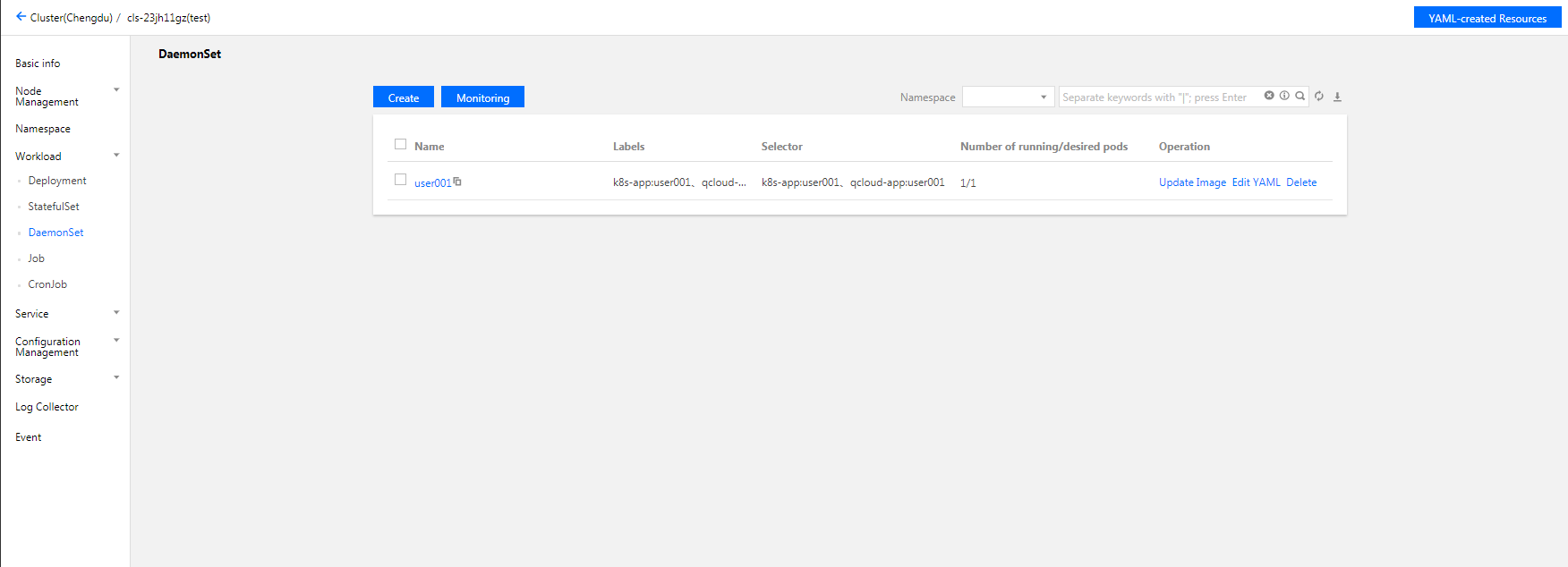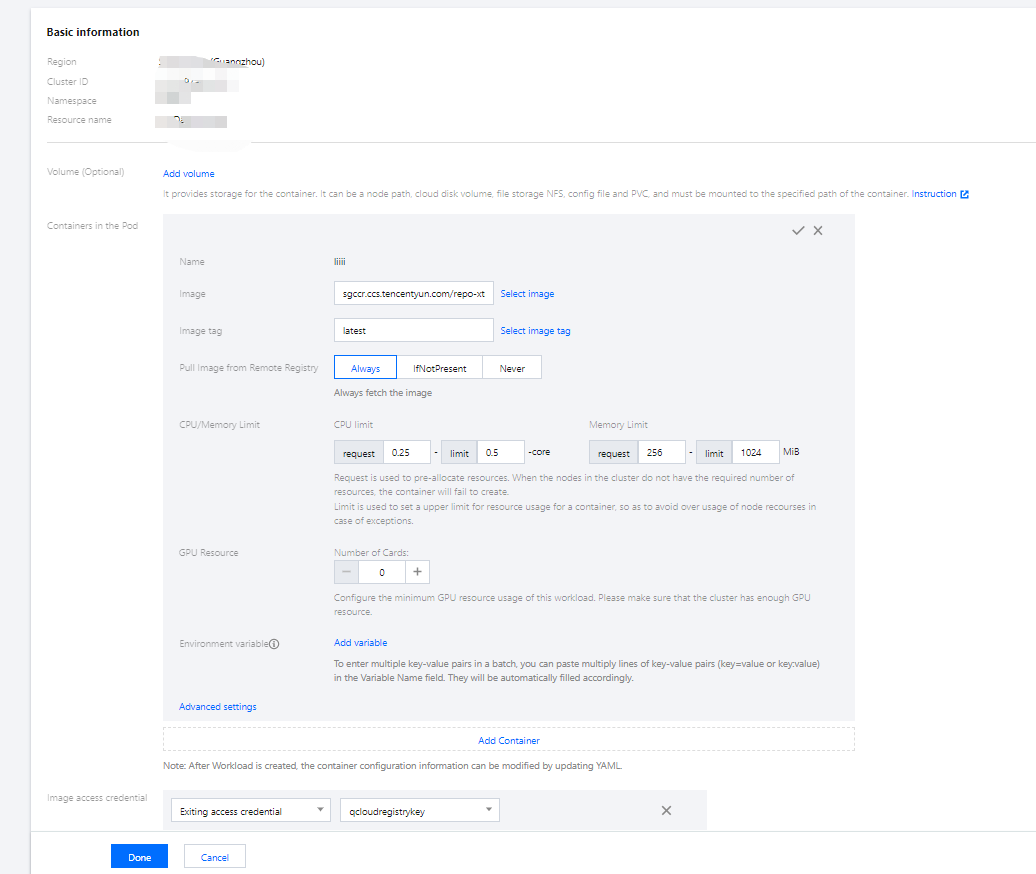DaemonSet 管理
最后更新时间:2024-12-19 22:09:58
简介
DaemonSet 主要用于部署常驻集群内的后台程序,例如节点的日志采集。DaemonSet 保证在所有或部分节点上均运行指定的 Pod。 新节点添加到集群内时,也会有自动部署 Pod;节点被移除集群后,Pod 将自动回收。
调度说明
若配置了 Pod 的 nodeSelector 或 affinity 参数,DaemonSet 管理的 Pod 将按照指定的调度规则调度。若未配置 Pod 的 nodeSelector 或 affinity 参数,则将在所有的节点上部署 Pod。
DaemonSet 控制台操作指引
创建 DaemonSet
1. 登录容器服务控制台,选择左侧导航栏中的 集群 。
2. 单击需要创建 DaemonSet 的集群 ID,进入待创建 DaemonSet 的集群管理页面。
3. 选择工作负载 > DaemonSet,进入 DaemonSet 信息页面。如下图所示:


4. 单击新建,进入新建 DaemonSet 页面。
根据实际需求,设置 DaemonSet 参数。关键参数信息如下:
工作负载名:输入自定义名称。
标签:一个键 - 值对(Key-Value),用于对资源进行分类管理。
命名空间:根据实际需求进行选择。
类型:选择 DaemonSet(在每个主机上运行 Pod)。
数据卷(选填):为容器提供存储,目前支持临时路径、主机路径、云硬盘数据卷、文件存储 NFS、配置文件、PVC,还需挂载到容器的指定路径中。
实例内容器:根据实际需求,为 DaemonSet 的一个 Pod 设置一个或多个不同的容器。
名称:自定义。
镜像:根据实际需求进行选择。
镜像版本(Tag):根据实际需求进行填写。
镜像拉取策略:提供以下3种策略,请按需选择。
若不设置镜像拉取策略,当镜像版本为空或
latest 时,使用 Always 策略,否则使用 IfNotPresent 策略。Always:总是从远程拉取该镜像。
IfNotPresent:默认使用本地镜像,若本地无该镜像则远程拉取该镜像。
Never:只使用本地镜像,若本地没有该镜像将报异常。
CPU/内存限制:可根据 Kubernetes 资源限制 进行设置 CPU 和内存的限制范围,提高业务的健壮性。
GPU 资源:配置该工作负载使用的最少 GPU 资源。
高级设置:可设置 “工作目录”,“运行命令”,“运行参数”,“容器健康检查”,“特权级”等参数。
镜像访问凭证:容器镜像默认私有,在创建工作负载时,需选择实例对应的镜像访问凭证。
节点调度策略:可根据调度规则,将 Pod 调度到符合预期的 Label 的节点中。
5. 单击创建 DaemonSet,完成创建。
更新 DaemonSet
更新 YAML
1. 登录容器服务控制台,选择左侧导航栏中的 集群。
2. 单击需要更新 YAML 的集群 ID,进入待更新 YAML 的集群管理页面。
3. 选择工作负载 > DaemonSet,进入 DaemonSet 信息页面。如下图所示:


4. 在需要更新 YAML 的 DaemonSet 行中,选择更多 > 编辑YAML,进入更新 DaemonSet 页面。
5. 在更新 DaemonSet 页面编辑 YAML,单击完成即可更新 YAML。
更新 Pod 配置
说明:
仅在 Kubernetes 1.6或更高版本中支持 DaemonSet 滚动更新功能。
1. 在集群管理页面,单击需要更新 Pod 配置的 DaemonSet 的集群 ID,进入待更新 Pod 配置的 DaemonSet 的集群管理页面。
2. 在需要更新 Pod 配置的 DaemonSet 行中,单击更新 Pod 配置。如下图所示:


3. 在更新 Pod 配置页面,根据实际需求修改更新方式,设置参数。如下图所示:


4. 单击完成,即可更新 Pod 配置。
Kubectl 操作 DaemonSet 指引
YAML 示例
apiVersion: apps/v1kind: DaemonSetmetadata:name: fluentd-elasticsearchnamespace: kube-systemlabels:k8s-app: fluentd-loggingspec:selector:matchLabels:name: fluentd-elasticsearchtemplate:metadata:labels:name: fluentd-elasticsearchspec:tolerations:- key: node-role.kubernetes.io/mastereffect: NoSchedulecontainers:- name: fluentd-elasticsearchimage: k8s.gcr.io/fluentd-elasticsearch:1.20resources:limits:memory: 200Mirequests:cpu: 100mmemory: 200MivolumeMounts:- name: varlogmountPath: /var/log- name: varlibdockercontainersmountPath: /var/lib/docker/containersreadOnly: trueterminationGracePeriodSeconds: 30volumes:- name: varloghostPath:path: /var/log- name: varlibdockercontainershostPath:path: /var/lib/docker/containers
注意:
以上 YAML 示例引用于
https://kubernetes.io/docs/concepts/workloads/controllers/daemonset, 创建时可能存在容器镜像拉取不成功的情况,仅用于本文介绍 DaemonSet 的组成。kind:标识 DaemonSet 资源类型。
metadata:DaemonSet 的名称、Label等基本信息。
metadata.annotations:DaemonSet 的额外说明,可通过该参数设置腾讯云 TKE 的额外增强能力。
spec.template:DaemonSet 管理的 Pod 的详细模板配置。
Kubectl 创建 DaemonSet
1. 参考 YAML 示例,准备 StatefulSet YAML 文件。
2. 安装 Kubectl,并连接集群。操作详情请参考 通过 Kubectl 连接集群。
3. 执行以下命令,创建 DaemonSet YAML 文件。
kubectl create -f DaemonSet YAML 文件名称
例如,创建一个文件名为 fluentd-elasticsearch.yaml 的 StatefulSet YAML 文件,则执行以下命令:
kubectl create -f fluentd-elasticsearch.yaml
4. 执行以下命令,验证创建是否成功。
kubectl get DaemonSet
返回类似以下信息,即表示创建成功。
NAME DESIRED CURRENT READY UP-TO-DATE AVAILABLE NODE SELECTOR AGEfrontend 0 0 0 0 0 app=frontend-node 16d
Kubectl 更新 DaemonSet
执行以下命令,查看 DaemonSet 的更新策略类型。
kubectl get ds/<daemonset-name> -o go-template='{{.spec.updateStrategy.type}}{{"\\n"}}'
DaemonSet 有以下两种更新策略类型:
OnDelete:默认更新策略。该更新策略在更新 DaemonSet 后,需手动删除旧的 DaemonSet Pod 才会创建新的DaemonSet Pod。
RollingUpdate:支持 Kubernetes 1.6或更高版本。该更新策略在更新 DaemonSet 模板后,旧的 DaemonSet Pod 将被终止,并且以滚动更新方式创建新的 DaemonSet Pod。
方法一
执行以下命令,更新 DaemonSet。
kubectl edit DaemonSet/[name]
此方法适用于简单的调试验证,不建议在生产环境中直接使用。您可以通过此方法更新任意的 DaemonSet 参数。
方法二
执行以下命令,更新指定容器的镜像。
kubectl set image ds/[daemonset-name][container-name]=[container-new-image]
建议保持 DaemonSet 的其他参数不变,业务更新时,仅更新容器镜像。
Kubectl 回滚 DaemonSet
1. 执行以下命令,查看 DaemonSet 的更新历史。
kubectl rollout history daemonset /[name]
2. 执行以下命令,查看指定版本详情。
kubectl rollout history daemonset /[name] --revision=[REVISION]
3. 执行以下命令,回滚到前一个版本。
kubectl rollout undo daemonset /[name]
如需指定回滚版本号,可执行以下命令。
kubectl rollout undo daemonset /[name] --to-revision=[REVISION]
Kubectl 删除 DaemonSet
执行以下命令,删除 DaemonSet。
kubectl delete DaemonSet [NAME]
文档反馈

